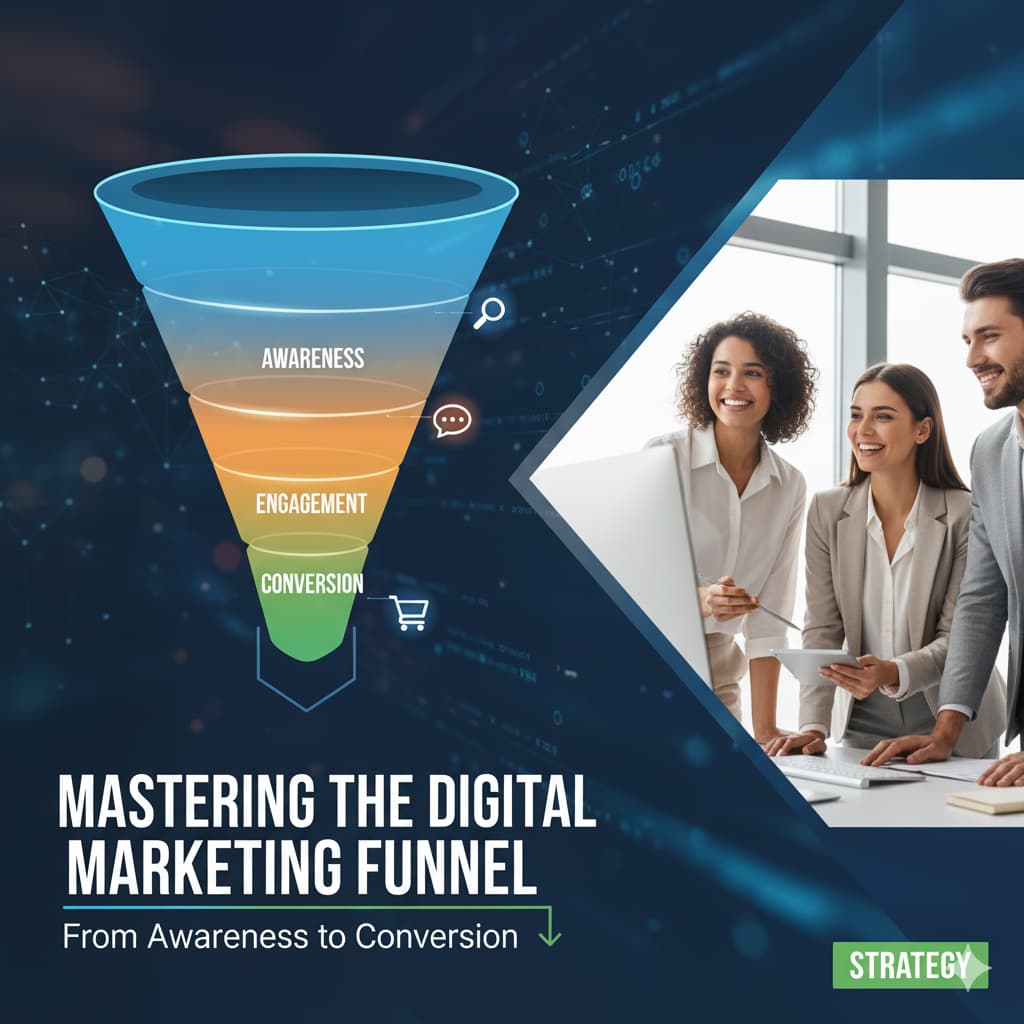Mastering the Digital Marketing Funnel: From Awareness to Conversion

In today’s digital era, competition is intense and customer expectations continue to rise. Businesses can no longer rely on random campaigns to achieve success. They need a structured pathway that moves potential customers from first interaction to loyal advocacy. This journey is called the digital marketing funnel. By mastering its stages, brands can convert casual visitors into long-term buyers. This guide explains each phase with practical insights and digital marketing funnel examples.
Understanding the Digital Marketing Funnel
The digital marketing funnel represents the journey a potential customer takes when interacting with a brand. It maps out the psychological and practical steps that transform awareness into action. Unlike the rigid and linear sales models of the past, today’s funnel reflects modern consumer behavior, where individuals may research extensively, compare multiple options, and even move back and forth between stages before reaching a decision.
The model is often divided into several digital marketing funnel stages, namely awareness, consideration, conversion, and beyond. Each stage plays a critical role in nurturing prospects, and success comes from ensuring that customers progress smoothly through these phases. For many organizations, professional guidance becomes necessary, and this is where a Digital marketing Agency in Dubai or a specialized provider of digital strategy services can deliver invaluable expertise.
Stage 1: The Awareness Phase - Grabbing Attention
The awareness phase is the entry point into the digital marketing funnel. It is at this stage that individuals first discover the existence of a brand. They may encounter it through search engines, social platforms, online ads, or even word-of-mouth. The goal here is not to push for a sale but rather to spark recognition and curiosity. Customers are usually just identifying a problem or need and are open to learning about possible solutions.
To succeed during this stage, businesses need to position themselves where their audience is most active. Content marketing serves as one of the most effective approaches, as educational blogs, videos, and guides can attract users who are seeking answers. Search engine visibility is equally crucial, which explains why many businesses partner with an SEO agency in Dubai to ensure their websites appear when prospects look for solutions. Paid advertising campaigns on platforms like Google and social media channels also help generate exposure, while strong branding and advertising services create consistency and memorability.
This is the moment where funnel marketing digital comes into effect. Rather than forcing direct sales, businesses aim to attract attention, foster engagement, and fill the funnel with qualified leads. Those who succeed at this stage set themselves apart early and establish the foundation for trust that will matter later in the journey.
Stage 2: The Consideration Phase - Building Interest
Once awareness is established, prospects begin to evaluate their options. This is the consideration phase, where customers no longer ask whether they have a problem but instead start comparing solutions to determine which brand deserves their trust. Here, the challenge for businesses lies in standing out from competitors by positioning themselves as the most reliable and relevant choice.
During consideration, prospects are looking for reasons to believe in a brand. They want proof that a product or service can genuinely solve their problem. Businesses must therefore offer value that goes beyond generic marketing messages. For instance, case studies, customer success stories, and testimonials act as powerful trust-builders. Email campaigns designed to nurture leads provide useful resources, helping prospects deepen their understanding of the brand’s offerings. Many digital marketing funnel examples illustrate how retargeting ads, which remind potential customers of products they viewed earlier, help keep a company top-of-mind during this critical stage.
A marketing agency in UAE can design strategies that align with cultural nuances, industry requirements, and consumer expectations in this region. By tailoring campaigns to meet specific needs, businesses create stronger emotional connections with prospects. The consideration phase is all about shifting perception, demonstrating authority, and proving that the brand can deliver on its promises.
Stage 3: The Conversion Phase - Driving Action
The conversion phase is where the real impact of the digital marketing funnel becomes visible. At this point, prospects are prepared to take action. They have completed their research, weighed the options, and are ready to make a decision. The conversion could take many forms, from purchasing a product and subscribing to a service to booking a consultation.
How to Achieve Success
To achieve success here, businesses must remove friction and create a seamless experience. Websites need to be optimized with clear calls to action that guide users effortlessly toward the next step. Landing pages should be persuasive yet simple, focusing on the benefits customers will receive rather than overwhelming them with excessive detail. Offers that create urgency, such as limited-time discounts or bonuses, can help accelerate decision-making. Ensuring that the checkout process is smooth, secure, and intuitive is equally essential.
The effectiveness of the digital marketing sales funnel depends heavily on how well this stage is managed. Even the strongest awareness and consideration campaigns can fail if prospects encounter confusion or obstacles during conversion. Professional digital strategy services can play a pivotal role in analyzing data, refining customer journeys, and ensuring that the funnel leads directly to measurable results. When executed correctly, the conversion phase becomes the turning point where investment in marketing translates into tangible revenue.
Beyond the Funnel: Retention and Advocacy
Many businesses make the mistake of thinking that the digital marketing funnel ends with a sale. However, the most profitable companies understand that the journey continues long after the first transaction. Retention and advocacy are critical elements that turn one-time buyers into repeat customers and loyal ambassadors.
Retention is achieved by maintaining consistent engagement after the purchase. Personalized follow-up messages, thank-you emails, and customized product recommendations remind customers that the brand values their relationship. Loyalty programs that reward repeat purchases encourage long-term commitment, while active customer support ensures that buyers feel supported.
Advocacy goes a step further. Satisfied customers naturally become advocates who recommend the brand to friends, family, or colleagues. This word-of-mouth effect amplifies growth at a fraction of the cost of traditional marketing. Companies often rely on branding and advertising services to reinforce their image, making it easier for satisfied customers to spread a consistent message. The cycle then comes full circle, as advocacy fuels new awareness, ensuring that the funnel remains alive and dynamic.
FAQs
What is the digital marketing funnel?
The digital marketing funnel is a structured framework that maps out the customer’s journey, starting with awareness, moving through consideration, leading to conversion, and extending into retention and advocacy. It helps businesses guide prospects in a strategic and purposeful way rather than leaving interactions to chance.
How long does it take to see results from a funnel?
The timeline varies depending on industry, competition, and marketing approach. Some businesses may notice improvements in visibility and engagement within weeks, but achieving consistent conversions can take several months. Working with experienced professionals, such as a Digital marketing Agency in Dubai, often accelerates this process by applying proven strategies.
Do I need a different strategy for B2B vs. B2C funnels?
Yes, Although the structure of the digital marketing funnel remains the same, the approach differs. B2B funnels usually require more time and deeper education, as multiple decision-makers are involved. In contrast, B2C funnels are often shorter and more emotionally driven, with buyers responding quickly to clear value propositions or attractive promotions.
Can a user skip a stage in the funnel?
It is possible. Some customers move directly from awareness to conversion if urgency is high or if they already trust the brand. For example, an individual might purchase immediately after discovering a product through an ad if the need is pressing. However, most customers progress through the funnel step by step, which is why it is important to design strategies that nurture prospects at every stage.
Also read: What is a CRM and Why Your Small Business Needs One to Survive






